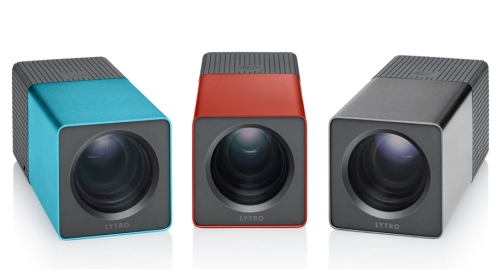Lytro Light Field Camera lets you focus after taking your shot

Just four months after Lytro created a ton of buzz by promising to revolutionize digital imaging, the Silicon Valley-based startup has announced its first product, theLytro Light Field Camera. The new camera, which is based on Lytro CEO and Founder Dr. Ren Ng's doctoral dissertation in computer science at Stanford, allows consumers to adjust the focus on their photos after they've already taken the shot. The basic concept is this: Rather than focusing on a single plane or object, the camera captures the entire light field of the scene, recording the color, luminosity (intensity), and vector direction of every ray of light. Armed with this multidimensional data, the camera can use computational algorithms to calculate what the image would look like if it had been focused at different distances. The result is what Lytro calls "living pictures" that can be refocused on the fly, after the fact. (The best way to grasp the concept is to take a look at Lytro's Living Picture Gallery and start clicking on the images in different spots to refocus them.)
The initial press release from back in June, though buzz-worthy, was met with plenty of skepticism (including a bit of my own), but now that there's a real product that's accessible to consumers (though steeply priced), they've got my attention. First there's the design: Rather than modeling the device on the expectations of a traditional camera (or any existing camera, for that matter), the designers at Lytro built the light field camera with simplicity and ease of use in mind. The camera uses a bright f/2.0, 8x optical zoom lens, and at just 1.61x1.61x4.41 inches in dimension and 8 ounces in weight, it looks more like a kaleidoscope or portable slide viewer than a camera. There are no mode dials to speak of -- in fact, controls consist of just two buttons (power and shutter), a touch-activated zoom slider, plus the 1.46-inch touchscreen LCD viewfinder. Second, because the camera depends on computational processing to achieve focus at different points on the image, rather than a complex set of lenses, it doesn't have the auto-focus mechanisms that slow down most digital cameras. This means no shutter lag (or, more accurately, auto-focus lag) to speak of and of course, less weight and complexity to the construction of the camera. Third, by capturing all available light in a scene with its f/2.0 lens, the Lytro camera inherently performs well in low light without a flash.
A few downsides: The internal Lithium Ion battery is not user replaceable, nor is memory expandable (the camera comes in 8GB and 16GB versions that hold 350 and 750 images respectively). And at $399 and $499 respectively, they're competing with some serious contenders for your digital camera dollars (think Canon PowerShot S95 and S100, entry-level dSLRs, or even some of the interchangeable lens compact cameras). But the biggest potential drawback (or the most exciting part, depending on how you look at it) is that the Lytro camera will require consumers to reimagine what they do with images. Sure it's cool that you can interact with images, focusing, and refocusing them. But at the end of the day, many consumers just want to snap their images and have them be in focus -- they don't want to have to fiddle with them. Most folks don't even want to bother with printing them, which is a bonus for Lytro since the two-dimensional resolution and image quality is limited. Lytro reps do a lot of dodging when asked what the 2D resolution of resulting images is, repeating some version of the following:
The Lytro is built for online sharing and interaction with pictures, not for large format printing. The living pictures you see in the Lytro Picture Gallery are representative of the image quality you can expect (but dependent on the screen resolution of your viewing device.) Asking about the pixel resolution of a light field camera system is not really relevant because pixels are very well defined. A pixel is color value and luminosity, and a light field camera's unit of capture is much more than that because each unit contains directional light ray data in addition to color and luminosity. Light field cameras capture megarays, not megapixels. The first Lytro captures 11 megarays. Our target resolution is HD at 1080p, but the full answer isn't completely straightforward. 2D projections in light field are rooted in computational photography, and 2D resolution can vary based on all sorts of factors including focal depth (refocus).
While valid, all that is probably said in an effort to redirect the question away from the answer which is that if you want to export to JPEG and print, you'll be able to choose a focus point and export at 1080x1080 pixels -- yep, a paltry 1.2 megapixels.
Still, as Lytro points out, the format is optimized for online sharing (which is what most people do with most images), not printing. But there's the rub. Unlike traditional cameras that perform in-camera processing to convert raw image files to compressed JPEG files that are ready to share and view straight from the camera, the Lytro requires a desktop application for for importing, processing, and interacting with the images from the camera, though the camera does process images internally to display on the LCD. (Note that the desktop app is currently Mac-only, but a Windows version is in development.) Furthermore, if you want to share the images with others online, you must first upload them to Lytro.com and then share them from there (via Facebook, Twitter, email links, etc.).
The biggest obstacle to widespread adoption, though, is price. At $200 and under, where the competition is tricked out point-and-shooters with tiny sensors, you might be able to win a lot of hearts and minds with the truly compelling (and fun) technology and promise that Lytro holds (although its lack of video capability might be a deal-breaker). But the folks who are ready to plunk down $400 to $500 on a camera are looking at higher-end cameras with vastly better image quality that shoot HD video, and they might not be as easily won over by the ability to click around an image changing up focus. Nevertheless, as the folks at Lytro keep pointing out, this is just the beginning. There's a lot more potential in light-field technology -- think immersive 3D: the data for it is already captured in the light field; you just need to perform the appropriate calculations and processing. If Lytro can pull through the first generation with at least some success, it just might be poised at the leading edge of the next digital imaging revolution.
Read more:
- Lytro Light Field Camera press release
- Lytro backstory
- Lytro CEO and Founder Ren Ng's Ph.D. dissertation on digital light field photography
- CNET Crave: Lytro unveils radical new camera design
- DPReview: Lytro Light Field Camera first look with Ren Ng
